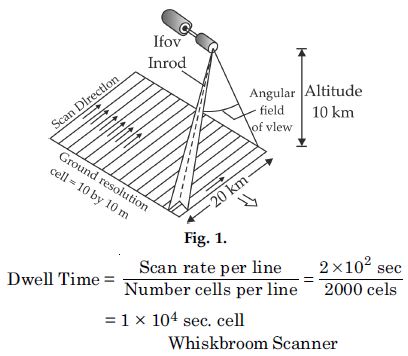Question 1:
Remote sensing of objects can be done
through various means such as
A. remote sensors
B. human eyes and
C. photographic system, which of the
following represents the true order of
their evolution.
- ABC
- BCA
- CAB
- None of the above
Answer:
(b). BCA
Question 2:
Which of the following regions of Electromagnetic spectrum is not used in satellite remote sensing?
- Microwave region
- Infrared region
- X-rays
- Visible region
Answer:
(b). Infrared region
Question 3:
Which of the following is not used in visual interpretation technique?
- Spatial arrangements of objects
- Frequency of tonal change on the image
- Location of objects with respect to other objects
- Digital image processing
Answer:
(c). Location of objects with respect to other objects.
Question 4:
Why is remote sensing a better technique then other traditional methods?
Answer:
Remote sensing is better technique other than traditional technique because this remote sensing is done by satellites which have capabilities of covering a large area.
Question 5:
Differentiate between IRS and INSAT series of satellites.
Answer:
The sensors recording the energy that they receive are placed in a near polar sun synchronous orbit at an altitude of 700-900 km. These satellites are known as remote sensing satellites. As against these satellites the weather monitering and telecommunication satellites are place in a geostationary position and revolves around the earth at an altitude of nearly 36,000 km.
Question 6:
Describe the operations of a whiskbroom scanner with the help of a diagram. Explain how it is different from pushbroom scanner.
Answer:
Whiskbroom scanner and its operation: The
whiskbroom scanner is made up of a rotating mirror
and a single detector. The mirror is so oriented that
when it completes a rotation, the detector sweeps
across the field of view between 90° and 120° to obtain
images in a large number of narrow spectral bands
ranging from visible to middle infrared regions of the
spectrum. The total extent of the oscillating sensor is
known as the total field of view of the scanner. The
pushbroom scanner consist a large number of ditietois
which are equalent to the number obtained by dividing
the swath of the senson. Whiskbroom scanner is made
up at relating mirror and single distictor.

Question 7:
Describe in brief the functioning of pushbroom scanner.
Answer:
The pushbroom scanners consist of a number of detectors which are equivalent to the number obtained by dividing the swath of the sensor by the size of the spatial resolution.
Question 8:
Identify and list the changes that can be observed in the vegetation of of Himalayas?
Answer:
The coniferous forests are disappeared and the deciduous forests have been taken place of coniferous forests.
